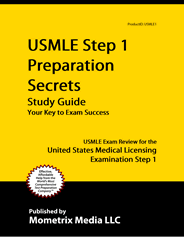United States Medical Licensing Examination (USMLE) Step 1, 2, and 3 Test Preparation Study Guide
The United States Medical Licensing Examination
(USMLE) is an examination for medical
licensure in the United States and is sponsored by the
Federation of State Medical Boards (FSMB) and the
National Board of Medical Examiners (NBME).
The Exam is administered in following three steps:
Step 1
It assesses whether a candidate can apply
important concepts of the sciences basic to the practice of medicine.
Step 2
It assesses whether a candidate can apply medical knowledge and skills of clinical science
essential for the provision of patient care under supervision
Step 3
It assesses whether a candidate can apply medical
knowledge and understanding of biomedical and clinical science essential for the unsupervised practice of
medicine.
Format Of The United States Medical Licensing Examination (USMLE):
All the three steps of the examination are administered in computer-based format. The content covered in each step is as followed:
Step 1:
The content is divided into following two domains:System
General principles
- Individual organ systems
- hematopoietic/lymphoreticular
- nervous/special senses
- skin/connective tissue
- respiratory
- cardiovascular
- gastrointestinal
- reproductive
- endocrine
- immune
Normal structure and function
Abnormal processes
Principles of therapeutics
Psychosocial, cultural, occupational, and environmental consideration
Step 2:
The content is divided into following two domains: Normal Conditions and Disease Categories Normal growth and development and general principles of careIndividual organ systems or types of disorders
Physician Task Promoting preventive medicine and health maintenance
Understanding mechanisms of disease
Establishing a diagnosis
Applying principles of management
Step 3:
The content is divided into following two domains: Clinical Encounter Frame:Initial Care
Continued Care
Emergency Care
Physician Task:
Obtaining history and performing physical examination
Using laboratory and diagnostic studies
Formulating most likely diagnosis
Evaluating severity of patient's problems
Applying scientific concepts and mechanisms of disease
Managing the patient
Free USMLE Practice Questions
Study Guide And Preparation Tips For United States Medical Licensing Examination (USMLE) Step 1, 2, and 3 Test
A Complete United States Medical Licensing Examination (USMLE) Step 1, 2, and 3 Test study guide that includes sample questions, test tips and a complete study plan prepared by a team of expert and dedicated researchers. Cost-effective and qualified exam help from a committed exam preparation company.
Click here to order USMLE Step 1 Preparation Secrets (printed book)
Click here to order USMLE Step 1 Preparation Secrets (ebook access)
